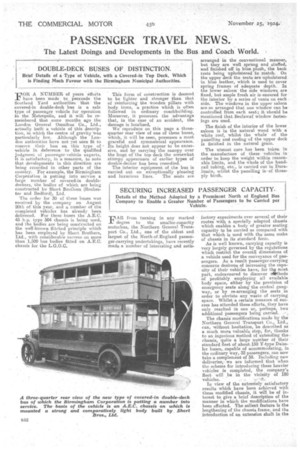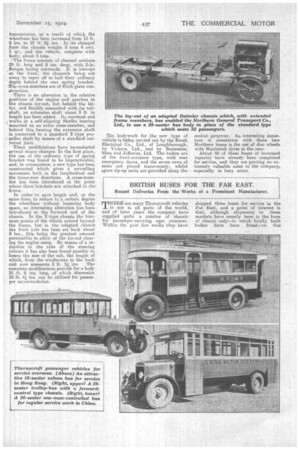SECURING INCREASED PASSENGER CAPACITY.
Page 26

Page 27

If you've noticed an error in this article please click here to report it so we can fix it.
Details of the Method Adopted by a Prominent North of England Bus Company to Enable a Greater Number of Passengers to be Carried per Vehicle.
FAR from turning in any marked • degree to the smaller-capacity motorbus, the Northern General Transport Co., Ltd., one of the oldest and largest of the North-of-England passenger-carrying undertakings, have recently made a number of interesting and satis. factory experiments over several of their routes with a specially adapted chassis which enablers a body of greater seating capacity to be carried as compared with that which is used with the same make of chassis in its standard form.
As is well known, carrying capacity is very largely governed by the regulations which restrict the overall dimensions of a vehicle used for the conveyance of passengers. As a result passenger-carrying concerns desirous of increasing the capacity of their vehicles have, for the most part, endeavoured to discover niiithods of profitably employing all available body space, either by the provision of emergency seats along the central gangway, or by re-arranging the seats in order to obviate any waste of carrying space. Whilst a certain measure of success has attended these efforts, they have only resulted in one or, perhaps, two additional passengers being carried.
The chassis modifications made by the Northern General Transport Co., Ltd., can, without hesitation, be described as a much more valuable step, for, thanks to an ingenious method of extending thechassis, quite a large number of their standard fleet of about 150 Y-type Daimler buses, capable of accommodating, in the ordinary way, 32 passengers, can now take a complement of 38. Including new deliveries, we are informed that when the scheme for introducing these heavier vehicles is completed, the company's fleet will be in the vicinity of 180 vehicles.
In view of the extremely satisfactory results which have been achieved with these modified chassis, it will be of interest to give a brief description of the manner in which the modifications have been effected. The salient feature is the lengthening of the chassis frame, and the introduction of an extension shaft in the
•
transmission, as a result of which the ' wheelbase has been increased from 13 ft. 6 ins. to 15 ft. 2 ins. In its changed form the chassis weighs 3 tons 4 cwt. I. qr., and the vehicle; complete with body, about 5 tons, The frame consists of channel sections 25 ft. long and 8 ins, deep, with 2-in,. flanges facing outwards. It is inswept
at the front, the channels being cut away to taper off to half their ordinary depth behind the rear spring bracket. ■ The-cross-rriembers are of flitch plate construction.
There is no alteration in the relative positions of the engine and gearbox in the chassis lay-out, but behind the 1stter, and flexibly connected with its tail` shaft, an extension shaft about 3 ft in length has been added. Its rearmost end , works in a self-aligning Skefko bearing mounted on an extra cross-member, and behind this bearing the extension shaft is connected to a standard Y-type propeller shaft by means of a standard uniyersal joint.
These modifications have necessitated several minor changes. In the first place, the use of the ordinary type of spring bracket was found to be impracticable, and, in consequence, a new type has been constructed which gives a swivelling movement both in the longitudinal and the transverse directions. A cross-member has been introduced at the point where these brackets are attached to the frame.
In order to save length and, at the same time, to reduce to a certain degree the wheelbase without lessening body space, an interesting alteration has been introduced at the forward end of the chassis. In the Y-type chassis the fore. most points of the wheels extend beyond the frame, but in the adapted. chassis the front axle has been set back about 8 ins., this being the greatest amount permissible to allow of the tie-rod clear. ing the engine sump. By means of a reauction in the rake of the steering column it has also been found possible to lessen the size of the cab, the length of which, from the windscreen to the back rest now measures 3 ft. 11 ins. The complete modifications provide for a body 21 ft. 6 ins. long, of which dimension 18 ft. 4,.; ins, can be utilized for passenger accommodation. The bodywork for the new type of vehicle is being carried out by the Brush Electrical Co., Ltd., of Loughborough, by Vickers, Ltd., and by Ransomes, Sims and Jefferies, Ltd. The bodies are of the front-entrance type, with rear emergency doors, and the seven rows of seats • are placed transversely, whilst spare tip-up seats are provided along the central gangway. An interesting departure in connection with these new Northern buses is the use of disc wheels with Macintosh tyres at the rear.
About 40 of these buses of increased capacity have already been complete.d for service, and they are proving an extremely valuable asset to the company, especially in busy areas.


































